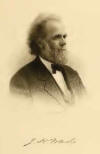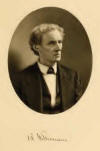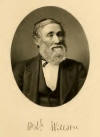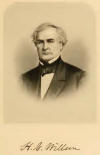|
Biographies
Source:
History
of Cuyahoga Co., Ohio
Published by D. W. Ensign & Co.,
1879
< BACK TO BIOGRAPHICAL INDEX FOR 1879 >
< BACK TO ALL
BIOGRAPHICAL INDEXES FOR CUYAHOGA COUNTY >
 |
JEPHTHA H. WADE Source: History of Cuyahoga Co., Ohio -
Published by D. W. Ensign & Co., - 1879 - Page 390
Portrait Source: History of Cuyahoga Co., Ohio - Published by D.
W. Ensign & Co., - 1879 - Page 280a |
 |
SAMUEL WILLIAMSON.
The subject of this sketch was born in Crawford county,
Pennsylvania, on the 16th of March, 1808. He is the eldest
son of Samuel Williamson, who was born in Cumberland
county, Pennsylvania, and removed to Crawford county about the
year 1800. During his residence in that county he was
married to Isabella McQueen, by whom he had a family of
seven children. On the tenth of May, 1810, he removed to
Cleveland, Ohio, where, in connection with his brother, he
carried on the business of tanning and currying, which he
continued until his death, which occurred in September, 1834.
He was a man of enterprise and public spirit, highly esteemed as
a citizen, liberal in politics, and for many years justice of
the peace and associate judge of the court of common pleas.
Samuel Williamson was but two years of age when
he came, with his parents, to Cleveland. When he attained
a suitable age he was sent to the public schools, which he
attended until 1826, and then entered Jefferson College, in
Washington County, Pennsylvania. He graduated that
institution in 1829, and, returning to Cleveland, entered the
office of Judge Andrews, with whom he read law for two
years. In 1832 he was admitted to the bar, and
immediately commenced the practice of his profession in
connection with Leonard Case, with whom he was associated
until 1834, when he was elected to the position of Auditor of
Cuyahoga county. He remained in that office for a period
of eight years, at the expiration of which he returned to the
practice of law. This he continued with slight
interruptions until 1872, when he retired from its activities to
the enjoyment of a well-earned leisure. During these years
his time was not, however, wholly engrossed by his professional
interests. He was elected to a number of responsible
positions of public trust, and discharged the duties pertaining
to them with unvarying fidelity and marked ability. In
1850 he was chosen to represent the county in the legislature;
in 1859-'60 he was a member of the board of equalization, and in
the fall of 1862 was elected to the State senate, in which he
served two terms. He rendered valuable service as a member
of the city council and of the board of education, being active
in promoting public improvements and educational institutions.
He was a director of the Cleveland and Columbus railroad, and
for two years held the office of prosecuting attorney. He
is now president of the Cleveland Society for Savings, one of
the largest and best conducted associations of the largest and
best conducted associations of this kind in the West, having a
deposit of over $8,000,000.
Throughout his professional career he maintained a high
rank at the bar of Cuyahoga county, and while he had a wide and
varied experience in every branch of legal practice he was
particularly successful as prosecutor's counsel, and was
extensively employed in the settlement of estates.
In all the phases of his career and life he has been
thoroughly upright, and well deserves the high respect and
esteem in which he is held by all who know him.
Source: History of Cuyahoga Co., Ohio -
Published by D. W. Ensign & Co., - 1879 - Page 392
Portrait Source: History of Cuyahoga Co., Ohio - Published by D.
W. Ensign & Co., - 1879 - Page 236a |

F. D. Willson |
FREDERICK WILLSON.
This well-known citizen of Mayfield was born in the town of
Phelps, Ontario county, New York, on the 4th day of January,
1807. He was the son of George and Esther Willson,
the latter of whom is still living with the subject of this
sketch, at the age of ninety-two years. He resided in
Phelps (most of the time after childhood being spent in
attending school or working on his father's farm) until the year
1830. In July of that year he came to Mayfield, where he
has ever since made his home.
The young pioneer located himself at the point now
known as Willson's Mills, and soon formed a partnership
with David McDowell in the mercantile and farming
business. Meeting with success in these occupations, the
firm in 1833 built a gristmill and a sawmill at the point just
named.
Meanwhile the subject of our sketch had taken an active
part in military affairs. Having served as private, non-commisioned
officer, lieutenant and captain, in a regiment of light
artillery. New York militia, before leaving that State, he
was, on the organization of Mayfield as a separate
company-district in 1833, elected the first captain of the first
company in that township. On the outbreak of the
celebrated "Toledo war," when it was expected that active, and
perhaps dangerous, service would be necessary in maintaining the
rights of Ohio to that city and the surrounding territory,
Captain Willson with his lieutenant and twelve men
volunteered to take part in the contest. In 1834 he was
elected major of the first regiment of infantry, second brigade,
ninth division, Ohio militia; in 1835 was promoted to
lieutenant-colonel, and in 1836 was chosen colonel. In
1838 Colonel Willson was elected brigadier-general, which
position he resigned about four years afterwards.
On the 6th day of September, 1836, Gen. Willson
was married to Miss Eliza Handerson, of the adjoining
town of Orange, a lady who has shared with him the joys and
sorrows of life down to the present time.
In 1837 Gen. Willson dissolved partnership with
Mr. McDowell taking the mill and farm as his share.
Milling and farming have been his occupations since that time,
and in both he has been extremely successful; being now the
owner of about nine hundred acres of land. In April, 1840,
his mills were destroyed by fire, but were rebuilt with
characteristic energy, being set running on the 7th of January,
1841. In 1875 they were transferred to the general's
eldest son, Myron H. Willson, who still owns and operates
them.
Gen. Willson became a member of the Masonic
order fifty-one years since, before leaving the State of New
York. He has passed through all the degrees from that of
entered apprentice to the Scottish rites, and maintains a high
standing among the brethren of the order.
Though never a politician, yet in 1846 his neighbors
elected him to the office of justice of the peace of Mayfield
township, and re-elected him in 1849; the whole length of his
service being six years.
General and Mrs. Willson have raised a family of
nine children, five sons and four daughters. Two of his
sons enlisted early in the war for the Union, and both gave
their lives in its defense. George A. Willson
enlisted in the First Infantry in the summer of 1861, at the age
of nineteen, and was killed at the battle of Resaca, Georgia,
May 14, 1864. James P. Willson also enlisted in
Battery B, First Light Artillery, the same summer, at the age of
seventeen, and died in service in June, 1862, having been
brought home from Nashville three weeks before his decease.
Source: History of Cuyahoga Co., Ohio - Published by D. W.
Ensign & Co., - 1879 - Page 370 |

H. V. Willson |
H. V. WILLSON
Source: History of Cuyahoga Co., Ohio - Published by D. W.
Ensign & Co., - 1879 - Page 393
Portrait Source: History of Cuyahoga Co., Ohio - Published by
D. W. Ensign & Co., - 1879 - Page 56a |
| |
HIRAM V. WILLSON. This gentleman, an eminent
lawyer and jurist, and the first judge of the United States
Court for the Northern District of Ohio, was born in April,
1808, in Madison county, New York. He was educated at
Hamilton College, graduating from that institution in 1832.
Immediately afterward he commenced the study of law in the
office of Hon. Jared Willson, of Canandaigua, New York.
Subsequently his legal studies were continued in Washington, D.
C., in the office of Francis S. Key, and, for a time, he
taught in a classical school in the Shenandoah valley.
During his early studies he acquired the familiarity
with legal text books and reports which in afterlife became of
great service to him. throughout his collegiate course,
and during his law apprenticeship, he maintained a close
intimacy with the Hon. Henry B. Payne, then a young man
of about his own age.
In 1833 he removed to Painesville, Ohio, but soon
proceeded to Cleveland, where he formed a law partnership with
his friend, H. B. Payne. They commenced business
under the most disadvantageous circumstances, being almost
destitute of means in a land of strangers. They, however,
met with encouragement from some of the older members of the
profession, and in a short time
established their reputation
as able and rising lawyers. After a few years years Mr.
Payne withdrew from the firm, and it became successively
Willson, Wade & Hitchcock and Willson,
Wade & Wade. By these partnerships even the
extensive business and high reputation of the old firm were much
increased.
In 1853 Mr. Willson was the Democratic
candidate for Congress against William Case on the
Whig, and Edward Wade on the Free Soil ticket. In
this contest Mr Wade was successful, but Mr.
Willson received a heavy vote.
In the winter of 1854 he was selected by the Cleveland
bar to labor in behalf of a bill to divide the State of Ohio,
for Federal judicial purposes, into two districts. After a
sharp struggle t he bill was successful— mainly through his
efforts—and the United States District Court for the Northern
District of Ohio was formed. In March, 1855, President
Pierce appointed Mr. Willson judge of the
court just authorized; an act which was received with general
satisfaction by the members of the bar.
Until the time of his appointment he had been a strong
political partisan, but in becoming a judge he ceased to be a
politician, and to the time of his death never allowed political
or personal motives to affect his decisions, lie proved himself
an upright judge, whose decisions were based entirely on the
facts of the case and its legal and constitutional bearings.
The new court did not lack for business. In addition to
the ordinary civil and criminal cases, the location of the court
on the lake border brought it a large number of admiralty suits.
Many of his decisions in these cases were regarded as models of
lucid statement and furnished valuable precedents.
Among the most noteworthy of his decisions in admiralty
was one regarding maritime liens, in which he held that the
maritime lien of men for wages, and of dealers for supplies, is
a proprietary interest in the vessel itself, and cannot be
divested by the acts of the owner or by any casualty until the
claim is paid, and that such lien inheres to the ship and all
her parts, wherever found, and whoever may be her owner.
In the case of L. Wick vs. the schooner "Samuel
Strong," which came up in 1855, Judge Willson
reviewed the history and intent of the common-carrier act of
Ohio, in an opinion of much interest.
In other cases he supported his decisions by citing
precedents of the English and American courts for several
centuries. A very important case was what is known in the
legal history of Cleveland as the "Bridge Case" in which the
questions to be decided were the legislative authority of the
city to bridge the river, and whether the bridge would be a
nuisance, damaging the complainant's private property.
Judge Willson's decision, granting a preliminary injunction
until further evidence could be taken, was a thorough review of
the law relating to water highways and their obstructions. In
the case of Hoag vs. the propeller "Cataract" the
law of collision was clearly set forth.
In 1860, important decisions were made in respect to
the extent of United States jurisdiction on the Western lakes
and rivers. It was decided, and the decision was supported by
voluminous precedents, that the admiralty and maritime
jurisdiction possessed by the district courts of the United
States, on the Western lakes and rivers, under the constitution
and the act of 1789, was independent of the act of 1845, and
unaffected thereby; and also that the district courts of the
United States having, under the Constitution and the acts of
Congress, exclusive original cognizance of all civil causes of
admiralty and maritime jurisdiction, the courts of common law
are precluded from proceeding in rem to enforce such
maritime claims.
In a criminal case the question was whether the action
of a grand jury was legal in returning a bill of indictment
found by only fourteen members of the jury, the fifteenth member
being absent and taking no part in the proceedings. After
reviewing the matter at length and citing numerous precedents,
Judge Willson pronounced the action legal.
In 1858 the historical Oberlin-Wellington rescue case
came before him, a case growing out of a violation of the
fugitive slave law by certain professors and leading men of
Oberlin College and town, who had rescued a slave captured in
Ohio and being taken back to Kentucky under the provisions of
that law. Indictments were found against the leading
rescuers, and their trial caused great excitement. They
were convicted, fined and imprisoned. The result caused a
monster demonstration against the fugitive slave law, which was
held in the public square, midway between the court-house and
the jail.
In this trying time Judge Willson
remained calm and dispassionate, his charges merely pointing out
the provisions of the law, and the necessity of obeying it, no
matter how irksome such obedience, until it was repealed.
During the excitement caused by the John
Brown raid, and afterward on the breaking out of the
rebellion, he defined the law in regard to conspiracy and
treason, drawing with nice distinction the line between a
meeting for the expression of opinions hostile to the
government, and a gathering for violently opposing or
overthrowing the government.
At the January term in 1864 he delivered an admirable
charge, in which he discussed the questions arising from the
then recent act of Congress, authorizing a draft under the
direction of the President, without the intervention of the
State authorities, and conclusively established the
constitutional validity of the act in question.
The judicial administration of Judge Willson
was noticeable for its connection with events of national
importance, and our limited space will allow us to quote but few
of the important cases which came before his court. And
here it should again be repeated that in all his conduct on the
bench he was entirely free from personal or party predelictions.
In 1865 his health began to fail and symptoms of
consumptionappeared. He yielded at last to the persuasions
of his friends to seek the restoration of his health in a milder
climate, and, upon the approach of the winter, visited New
Orleans and the West Indies. The weather proved unusually
severe for those latitudes and he returned without benefit from
the trip. He gradually sank under the attacks of the fell
disease, and died on the evening of the 11th of November, 1866.
A few hours before his death he suffered much, but he became
easier and passed away without a struggle. Some months
before he had been received as a member of the Presbyterian
Church, of which he had long been a member and an active
supporter.
On the announcement of his death the members of the
Cleveland bar immediately assembled, and all vied with each
other in rendering testimony to the integrity, ability and moral
worth of the deceased. The bar meeting unanimously adopted
resolutions of respect, in which he was truthfully described as
"a learned, upright and fearless judge, ever doing right and
equity among the suitors of his court, fearing only the errors
and mistakes to which fallible human judgment is liable."
Not a word of censure was breathed against any one of his acts,
and tributes of heartfelt commendation of his life, and
sorrow for his loss were laid on his grave by men of all parties
and shades of opinion. he was married, in 1835, to the widow of
Mr. Ten Eyck, of Detroit, Michigan, who survived him. He
also left a daughter, Mrs.
Chamberlain.
Portrait Source: History of Cuyahoga Co., Ohio - Published by
D. W. Ensign & Co., - 1879 - Page 393 |
| |
RUFUS KING WINSLOW
Source:
History of Cuyahoga Co., Ohio - Published by D. W. Ensign & Co.,
- 1879 - Page 394 |
| |
REUBEN WOOD
Source: History of
Cuyahoga Co., Ohio - Published by D. W. Ensign & Co., - 1879 -
Page 395 |
|
![]()
![]()




